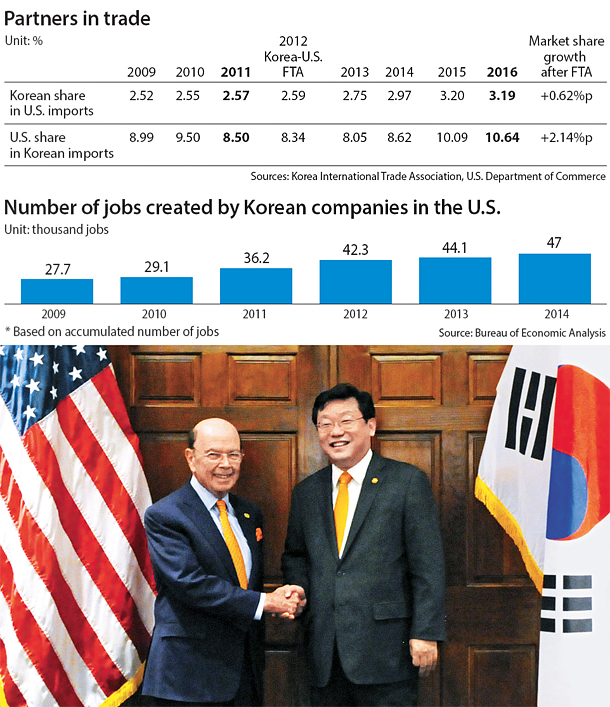Korea-U.S. FTA is a ‘win-win,’ says institute

Korean Trade Minister Joo Hyung-hwan, right, shakes hands with U.S. Commerce Secretary Wilbur Ross on Wednesday in Washington, D.C. This is Ross’s first ministerial-level meeting with a foreign counterpart, according to Korea’s Trade Ministry. [MINISTRY OF TRADE, INDUSTRY AND ENERGY]
According to the Institution for International Trade, a research body under the Korea International Trade Association, the U.S. share of the Korean import market grew 2.14 percentage points to 10.64 percent last year compared to 2011, a year before the pact came into effect.
It was the highest market share for American exporters in the Korean market since 2006, according to the report.
Korean exporters’ presence in the U.S. market also grew, but at a smaller rate of 0.62 percentage points from a 2.57 percent share in 2011 to 3.19 percent last year.
“Amid faltering trade globally, the Korea-U.S. FTA has propped up bilateral trade and benefitted both countries,” said Jung Hye-sun, an analyst from the Korea International Trade Association.
According to the report, while global trade sank at an average 2 percent annually over the last five years, trade between Korea and U.S. grew by an average 1.7 percent every year.
The greatest beneficiary of the bilateral pact were U.S. automakers, which rapidly expanded their market share in the Korean market. Right after the pact took effect in 2012, the 8 percent tariff on U.S. imported cars to Korea was halved to 4 percent for four years. Last year, tariffs were completely lifted.
American automakers’ market share in the Korean market increased to 18.1 percent last year from less than 10 percent before the FTA. Pharmaceutical imports from the U.S. also grew by 12.9 percent annually as roughly 8 percent tariff was removed.
During his presidential election campaign, Trump described the accord with Seoul as a destroyer of jobs in the U.S. auto industry.
However, the report said Korea’s investments in the U.S. over the five years under the FTA amounted to $51.18 billion, contributing to the creation of more than 5,000 new jobs based on data through 2014. The accumulated investment exceeds the roughly $31.02 billion invested by the U.S. in Korea under the agreement.
Korea’s Trade Minister Joo Hyung-hwan has also been eager to promote the Korea-U.S. FTA after Trump’s repeated characterizations of the pact with Seoul as “unfair.”
According to the Korean Ministry of Trade, Industry and Energy on Thursday, Joo met with U.S. Commerce Secretary Wilbur Ross on Wednesday in Washington D.C. and told him that the FTA helped the two countries’ trade volume expand by 15 percent from 2011 to 2015, while the world’s trade volume decreased by 10 percent in the same period.
“Korean investments created about 10,000 jobs in the United States from 2011 to 2015 and average yearly wages paid by Korean companies operating in the U.S. are $92,000 per worker, which is the most among other Asian countries,” Joo told Ross, according to Korea’s Trade Ministry.
BY KIM JEE-HEE, KIM YOUNG-NAM [kim.jeehee@joongang.co.kr]










with the Korea JoongAng Daily
To write comments, please log in to one of the accounts.
Standards Board Policy (0/250자)